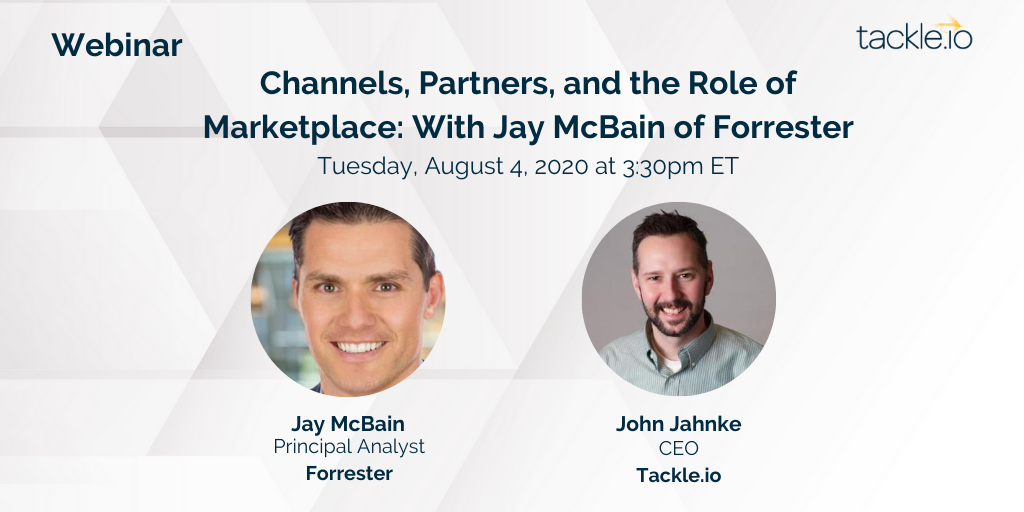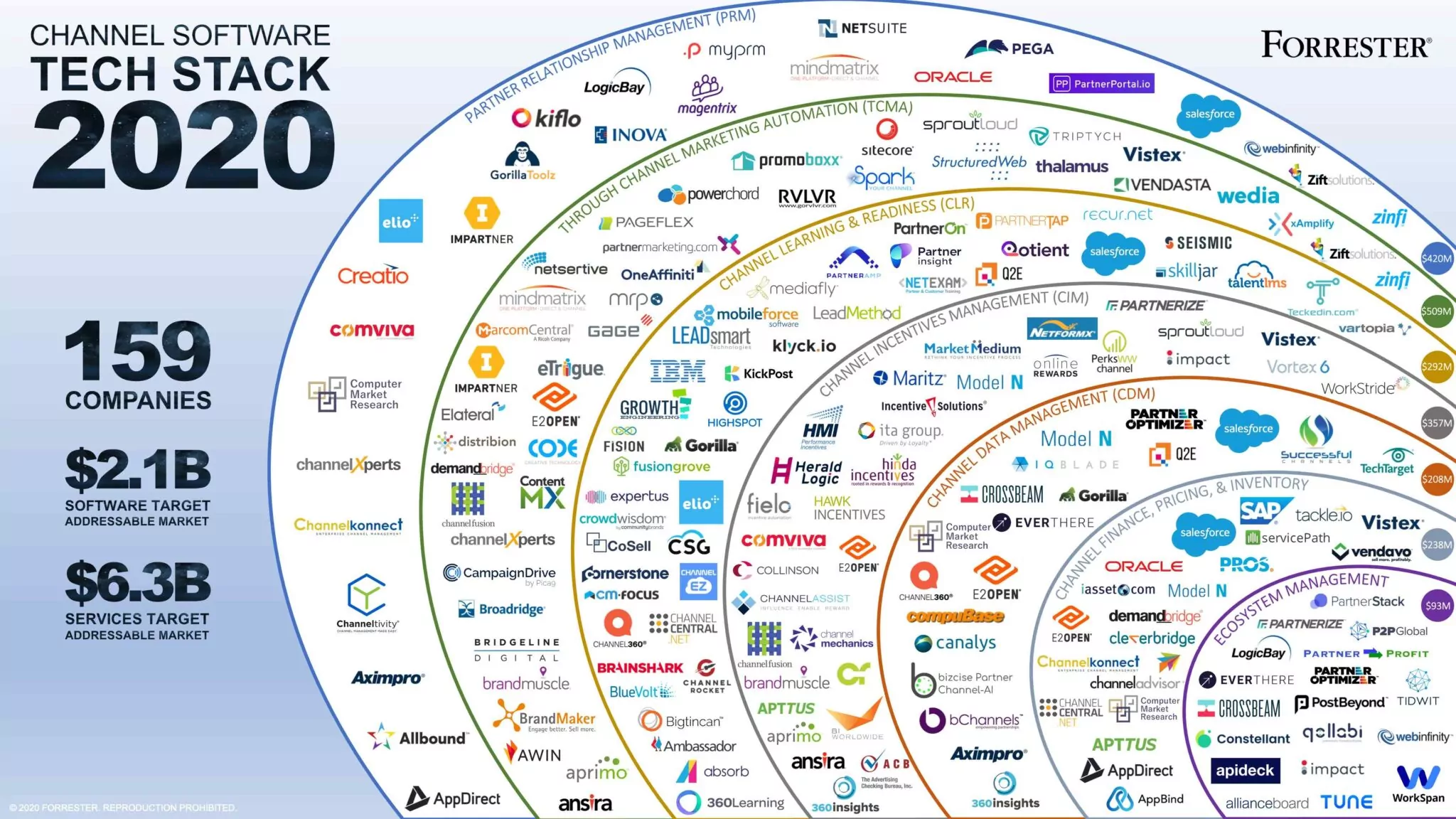
If anyone has their fingers on the pulse of evolution of the cloud , it’s Jay McBain. Jay is the Principal Analyst of Channels, Partnerships & Alliances at Forrester, and brings years of experience to his current role. His expertise, along with his recent findings in Forrester’s Channel Software Q2 report, all point to the same idea—software sales is changing rapidly.
In our recent webinar, Channels, Partners, and the Role of Marketplace: With Jay McBain of Forrester, we discussed:
- Forrester’s latest Channel Software Tech Stack Report and what it means for established companies and startups alike
- Why you need to start thinking about your partner ecosystem
- How Marketplaces have grown this year, driven by aggressive growth and migration to the Cloud
- What the next generation of channel leaders should do to succeed
We took a few key takeaways from our discussion about how companies can stay ahead of the curve.
Companies should consider their customer’s tech stack
Today, there are 175,000 software companies, which could grow to a million in the next ten years. As if that forward-looking number wasn’t impressive enough, Jay McBain reminds us, “There were only 10,000 software companies ten years ago— so we’re in hyper-growth.”
As more software companies arise, and more companies in general look to buy solutions, there comes a realization that your product needs to play nice with others.
Before joining Forrester, Jay was the CEO of a channel software company that had to consider how his solution fit his customer’s tech stack and ecosystem.
Jay noted that “the average software buyer will buy seven different things to solve their problem. As a channel software company, I knew that I didn’t connect the dots between the 100 things you need to do to recruit and manage partners.”
Since Jay’s company wasn’t an all-in-one solution, he began to wonder, “who was I going to be partnered and integrated with as part of my ecosystem?”
As Jay researched related companies to understand his position in the market, he found 159 companies that worked along different elements of the Channel Stack.
“Of these 159 companies, 155 of them were non-competitive to our company, since customers use your platform in and around others.”
From these realizations came the Channel Software Tech Stack, which maps out the “technologies that firms leverage to plan with, find, recruit, onboard, develop, enable, incentivize, cosell with, comarket with, manage, measure, and report on partners.”
The 2020 edition of the landscape maps 159 companies across seven categories and represents a $2.1B software market and $6.3B services market. For channel software companies, “it’s a map of the people you need to partner and integrate with.”
While the channel tech stack only considers tools that help companies leverage partnerships, its growth signals a rising demand in channels. Cloud Marketplaces are one channel for companies to sell through, and Cloud Providers themselves can act as strategic partners with co-sell opportunities, like AWS’ APN/ACE program and Microsoft’s co-sell program.
If you’ve been curious about Marketplaces (MPs), now’s the time to get on board, since Jay believes leveraging channels like AWS, Microsoft Azure, and Google Cloud Platform will become more critical in years to come.
As companies and customers evolve, partnerships will become even more vital
When you consider that 73% of B2B buyers report that buying through ecommerce, web direct, or Marketplaces is very convenient, it’s no surprise that analysts like Jay forecast aggressive Cloud Marketplace growth. He believes there are three elements leading to an increased focus on partnerships.
First, every company is being disrupted by changing customer preferences, leading to greater technology and software adoption. Jay shared that “Companies are doing more integrations and understanding the power of software and partnerships.”
Second, there are also more companies turning to subscription-based business models. “Instead of one time sales, everybody’s rethinking ‘as a service,’ and having to re-earn their customers’ trust every 30 days,” Jay added.
Finally, companies are increasingly obsessed with being customer-centric and understanding the customer journey. By inspecting every moment from “the point they have a pain, to the point of transaction, and then renewal,” companies understand each step that they can influence and process to optimize.
Having a holistic view of the customer journey also highlights where partnerships would be helpful or where influencers could sway decisions. That’s how the ecosystem you’re building really comes together.
So, where does this leave companies? As more organizations embrace growing tech stacks and mountains of moving parts, Jay predicts that channel and partnership management will evolve. Buyers like Cloud Marketplaces because of the ease of procurement and established Cloud Provider budget, which means companies need to adapt to meet buyers where they are.
Whereas sales and marketing roles have taken turns transforming from being based in art to being driven by science and data, the partnership economy will be the next big turning point for software companies.
“What was left out of that equation for the last 20 years is that 75% of sales go indirectly.” Jay predicts that the ecosystem between channel partners will drive business in the next ten years.
“Interviewing for a Head of Alliances or Partnerships job today versus five years from now is going to look very different. In the future, you’ll be talking about the science of partnerships, instead of wining and dining people in sunny locations.”
Cloud Marketplaces have skipped years ahead in expected growth curves
Of course, since Jay has spent so much time analyzing channels and partnerships, we had to ask his perspective on the future of Cloud Marketplaces.
John Jahnke, CEO at Tackle, noted that “for so long, tech was very B2B focused. Then over the last 20 years, the consumer-side evolved, and now we’re at this point where B2B is almost behind. You can do more from a consumer standpoint in some ways.”
It may not take as long for B2B channels to catch up as was once expected.
“Marketplaces are a trend we’ve been watching closely for years, and there’s a bunch of converging things that are happening that are driving growth. And I think COVID has been kind of the cherry on top,” Jay shared.
“As everybody turns into subscription businesses, customers want a central place where they can procure and leverage multiple solutions in one place,”
In the past few months, Jay has seen Marketplace growth outpace what it had done in the previous decade.
“We’ve had ten years of e-commerce and Marketplace growth in the last three months, which is amazing.”
Jay continued, “the journey that B2B buyers are on is becoming more consumer-led. That’s why we made a pretty stark forecast on Marketplaces before COVID. Forrester said, “17% of B2B transactions would go via e-commerce, Web Direct, and Marketplaces by 2023. After COVID, we’re going to hit that number late this year or early next. It doesn’t sound like a lot when 73% of the buyers prefer it, and only 17% of the dollars flow that way until you look at the $13 trillion B2B market.”
The three Marketplaces that Tackle customers list on have seen amazing growth of their own, too. Jay noted that “Azure grew by 59% before COVID, and grew by 47% after a quarter of COVID.”
He continued, “Cloud Marketplaces are resilient to pandemics and pandemonium. When I look at others, AWS grew by 54% before COVID, and now they’re growing by 41%. I think Google grew by 51%, and now they’re still at 40%.”
Customer-centricity should guide your Marketplace expansion
After growing your presence on one Cloud Marketplace, your company may wonder if and when it’s time to expand to other MPs. Jay’s advice for moving to other Cloud Marketplaces is “if you’re customer-obsessed as a company, your customer will always lead you. “
John added that “Sellers want to sell where buyers want to buy.” And buyers typically want to buy where they run the majority of their applications and infrastructure.”
Jay also reminded the community to think about the complementary services that your customers will use alongside your solution.
“Your customers are going to buy seven products, on average, to solve their problem. You’re trying to compete to be one or more of those layers of the cake. So, you need to fixate on who those six other layers are and be in those networks. You also need to make sure that you’re integrated and that your APIs are friendly.”
Ecosystem executives will need to juggle sales channels
To wrap up, Jay shared his advice for channel leaders who may be looking to advance to the boardroom as an ecosystem executive. Channel executives aren’t often in the boardroom today, but Jay noted that “76% of CEOs think ecosystems are going to drive the future of their business model, and that’s going to earn channel leaders a seat at the table.”
Jay predicts that future ecosystem executives will look more like today’s alliance managers than transactional channel chiefs. Ultimately, that individual who builds the capacity to run a trifurcated channel model and execute Marketplaces simultaneously with the other transactional modes is the person that’s going to earn the seat.”
The “trifurcated channel model” that Jay references consists of an influencer channel of advocates, a traditional transactional channel, and a retention channel to help subscription companies thrive. If you want to learn more about Jay’s vision for channel professionals, you can read his 2020 channel predictions here.
The world of software is always evolving, and it’s essential to consider not just how customers use your platform, but also which companies you’ll be used alongside. To hear more of Jay’s thoughts on the future of channels and partnerships, listen to the full Channels, Partners, and the Role of Marketplace webinar here.
And don’t forget to check out Tackle’s State of Cloud Marketplaces Report to learn more about Marketplace adoption and the impact of Cloud Marketplaces on software sales and revenue growth.



